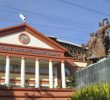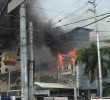Privatization of economic activities and public services is also on the rise. Over US$4 billion of public assets have been transferred to the private sector. Such has been the case of the oil industry, of the Electric Power Industry Reform Act (2001), of the reprivatization of Maynilad water corporation (2006), of the privatization of public infrastructure (RA 7718).
Liberalization of the economy has been promoted by various means. The series of tariff reform programs have brought reductions of agricultural tariffs from 43 % in 1981 to 11 % in 2003 and industrial ones from 39 % in 1981 to 5 % in 2003 (TRP I, II and III). Free Economic Zones have been encouraged (RA 7916). Free Trade Agreements are prepared with the USA (US-RP FTA), and have been signed with Japan (JPEPA) and Asean countries (AFTA). The Public Act on foreign investments opened the way for external capital in the fields of natural resources (RA 7942 for mining), agriculture (RA 7652), utilities (RA 7721), airlines (1995), retail trade (2000), and others. Efforts have been made to remove the economic sovereignty and national patrimony foreseen by the 1987 Constitution. Foreign investments have increased from 6% of the GDP in 1980-1984 to 16% in 2000-2005, and in 2005 it had a cumulative value of US$ 19 billion.
As a consequence, wealth has been concentrated among very rich people. The 1000 top corporations have increased their annual net income by 325% between 2001 and 2005 and the top ten percent of the population have incomes 22 times that of the poorest ten percent. Additionally, the overall estimate of money lost through corruption is estimated by the Ombudsman at US$24 billion for the period between 2001 and 2005 and is estimated at US$ 4 billion in 2006, equivalent to 20% of the Government budget. Capital repatriation has reached US$20 billion since 1980 and mineral resources have been plundered: to the equivalent of US$25 billion of exports since 1970.
Furthermore the Filipino people have to pay for increasing foreign debt. The current total public sector debt stock P6.0 trillion (US$120 B), equivalent to 110% of GDP, ate up 85% of total revenue for debt service in 2005. It is the highest in the history of the Philippines. As a consequence spending on vital economic and social services was slashed in order to pay for debt. Interest payments has now gone up to 35% of the budget share in 2006 which is five times more than the combined budget for education, health and housing spending
Local industry has been destroyed and denationalized. Between 1995 and 2000, four firms were closing every day and this number doubled between 2001 and 2005. In 2005, 3,054 firms closed and 57,921 workers were displaced, increasing unemployment. Corporatization of land ownership has subverted the sham Comprehensive Agrarian Reform Program resulting in the reconcentration of land.
Communities of the poor especially the women and children today pay the heavy price of debt repayment and privatization policies where, due to the neglect of the health care system and drastic cuts in public spending, child and maternal mortality has worsened. This has resulted in only 37% of pregnant women receiving vaccine.
In the urban areas only 54% of the women delivered in a health facility, while in the rural communities, only 22% delivered in a health facility; and 59% were unassisted by doctor/nurse/midwife.
Extrajudicial Killings









